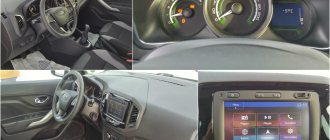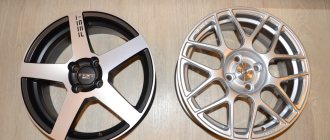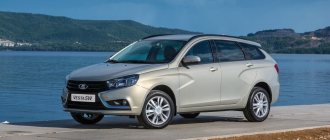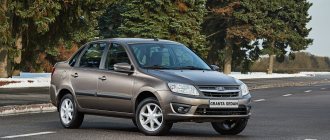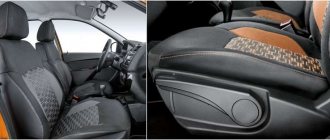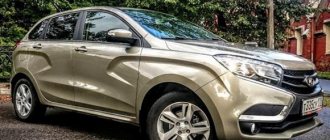The 2021 model year LADA Vesta SW Cross began as the second most popular cross-version of a passenger car in Russia. The first place still remains with the KIA Rio X-Line, which also happens to be the best-selling foreign car in our country.
This pick will definitely continue, because the “off-road” Vesta SV Cross 2021 in the new station wagon continues to expand its equipment and, in addition to increased ground clearance and plastic body protection, is ready to offer a choice of three power plant options, as well as “mechanics” or a modern CVT.
On the page all the details about the new Lada Vesta SV Cross body for the 2021 model year:
- Options and prices;
- Photo;
- Specifications;
- Video test drive.
Review
The difference between the classic version and the cross-configuration SW.
The production of SW Cross began in 2021, and this model immediately became a favorite of the domestic car market, as it offers a stylish exterior that does not at all resemble the eternal classic of AvtoVAZ and, according to most experts, looks much nicer than the design of its Korean competitor.
The main difference between the Lada Vesta Cross 2021 model year and the regular Vesta station wagon is that it is increased by 25 mm. ground clearance, which, coupled with body protection, immediately gave this car a few extra points of advantage.
In addition, with the plastic “edging” the rear pillars have become much more aesthetically pleasing, on which glossy black inserts have been preserved to achieve the effect of a floating roof.
Dimensions of the cross version:
- length – 4424 mm;
- width – 1785 mm;
- height – 1537 mm;
- wheelbase – 2635 mm;
- ground clearance - 203 mm.
Body
The design of Vesta was drawn by the Briton Steve Mattin, and the X-face he created with characteristic stampings on the sides of the body have long become signature features of modern AvtoVAZ cars. All this continues to be adorned by the 2021 Lada Vesta SV Cross station wagon, which has received a minimal number of external modifications such as enhanced tinting of the rear windows or original alloy wheels with a diameter of 17 inches.
Salon
The interior of the Russian station wagon fully complies with the “car priced up to 1 million rubles” bar, and therefore does not offer soft plastic or high-quality material that imitates leather.
At the same time, the 2021 KIA Rio X-Line also does not stand out in this regard, because the task of budget pre-crossovers comes down to providing a practical, moderately ergonomic and visually attractive interior. At the same time, the Russian Vesta tries to please with its pleasant atmospheric lighting and bright tidy, and in terms of trunk capacity it has clearly surpassed the “Korean”: 480 liters versus 390.
Technical stuffing
Like a regular station wagon, the engine range of the Lada Vesta SW Cross 2021 includes three units:
- 1.6-liter for 106 liters. With. (148 Nm);
- 1.6-liter for 113 liters. With. (152 Nm);
- 1.8-liter for 133 liters. With. (170 Nm).
All of them are designed to consume 92-octane gasoline, while the most economical (7.3 liters per 100 km in mixed mode) is the least powerful engine, and the best dynamics (10.9 seconds to “hundreds”) are demonstrated by the 1.8-liter power point. The base transmission for the model is a five-speed manual, but it comes only with domestic engines of 106 and 133 hp. With.
For the French four-cylinder H4M unit from Renault/Nissan, AvtoVAZ offers a non-alternative CVT.
Video of the “Big Test Drive”
What else you can read:
- Sang Yong Kyron 2016-2017 – Updated configurations
- Zotye T600 (Zoti) – Premium catch
- Kia Quoris 2021 – Large Barge
- Updated Acura MDH 2021 – When you want to stand out
- Volkswagen Atlas 2021 – 7-seater Tuareg killer
- 2021 Lincoln Navigator - Luxury = Space
- Opel Insignia Country Tourer 2021 – The epitome of individuality
- Gili NL3 – Who said that the first pancake was lumpy?
Vesta SW Cross with Japanese CVT
Jatco JF015E - these “boxes” are brought to the Russian car plant in Izhevsk from South Korea, and the increase in cost for modifications with a CVT is 50 thousand rubles.
For the first time, such a transmission began to be installed on the LADA X-RAY Cross, and then on the Vesta SV Cross - with the same 113-horsepower engine, which, as is known, in tandem with the same variator is successfully used on many models, including Capture, Logan and Duster.
According to reviews, this “box” is more suitable for measured driving in city mode and is designed for buyers who do not plan to “knead the dirt” and test the off-road qualities of their “cross-station wagon”.
Do Cross's competitors have 4x4 drive?
Renault Sandero Stepway and Renault Duster are produced with a front drive axle, but modifications for Europe can be purchased with 4WD. The Duster hatchback was created by Romanian developers as an urban crossover, with front-wheel drive and, of course, without inter-wheel locks. To travel to the country and conquer off-road conditions, you will have to increase the budget for the purchase of an all-wheel drive car. The same can be said for the Renault Sandero Stepway.
Renault Capture has 2 drive axles, but is much more expensive than Vesta. Renault Kaptur is a crossover with full 4WD traction, suitable for use in Russian conditions. On the one hand, it is similar to the model from Europe, on the other, it has a completely different design solution. Russian experts who examined the Kaptur in our conditions came to the conclusion: the car’s interior is cramped, the hatchback’s short-travel suspension, designed for European roads, is not energy-intensive enough and frankly reacts harshly to irregularities.
The Hyundai ix 35, which has a starting price of 939,900 rubles, has a 4-wheel drive, feels comfortable on slippery roads in winter, in spring thaw, and on sand in summer. “IX Thirty-Fifth” is based on the “Tukson” (by the way, in Korea it is still called Tukson with the index “ix”). It is close to the third generation Kia Sportage, they share a common platform. It was presented at an exhibition in Frankfurt in 2009.
Hyundai Creta also has 4wd. The Creta's full traction system is a system that transmits engine power to each wheel of the car. A 4x4 drive is needed by any crossover to increase traction when overcoming unfavorable sections of the road with ice, mud, and sand. 4 wd is switched on when driving in off-road conditions with the speed reduced to the minimum level.
Modifications and options for Russia
The Comfort level of equipment was chosen as the base for the Lada Vesta SW Cross 2021, which already has alloy wheels, side mirrors with turn indicators, an on-board computer, cruise control, heated front seats, air conditioning, a light sensor, rear parking sensors, power windows for the front doors, a monochrome display 4.3″ audio systems, etc. The “top” Luxe Prestige package, which raises the cost of the station wagon to 1 million rubles, and, among other things, adds climate control, a rain sensor and a standard navigation system.
Boards
Before that, the only “hardware” open-source projects that I assembled myself, using gerberas and BOMs as initial data, were the cantact CAN adapter and the ST-link clone.
There were no problems with the manufacture of boards, FR4-1.5mm/35µm. The difficulty is advanced, but oh well. To reduce the cost, I combined the boards into a kit using GerberPanelizer.
This time the fiberboard from Rezonit arrived with the ghosts of other people's PC/104 boards. Most of the components were in stock in stores (autumn 2020), a few more were replaced with analogues, and only a couple of rare items had to wait several weeks. I learned by chance that radiators are installed on the Brake module board from a picture posted on Twitter.
A couple more photos of the Brake unit
Result:
More photos
Specifications
| Modifications | 1.6 l 106 hp (gasoline) manual transmission | 1.8 l 122 hp (gasoline) manual transmission | 1.8 l 122 hp (petrol) AMT |
Are common | |||
| Production year: | 2019 — | ||
| Brand country | Russia | ||
| Country of assembly | Russia | ||
| Number of places | 5 | ||
| type of drive | Front | Front | Front |
| Guarantee | 3 years or 100,000 km | ||
Dynamic characteristics: | |||
| Acceleration to 100 km/h | 12,3 | 11,2 | 13,3 |
| Maximum speed | 178 | 180 | 180 |
| Ground clearance | 203 | 203 | 203 |
Fuel consumption (l): | |||
| City | 9,7 | 10,7 | 10,1 |
| Route | 6 | 6,4 | 6,3 |
| Average | 7,5 | 7,9 | 7,7 |
Motor | |||
| Motor type | Petrol | Petrol | Petrol |
| Brand | VAZ-21129 | VAZ-21179 | VAZ-21179 |
| Power | 106 | 122 | 122 |
| Torque Hm | 148 | 170 | 170 |
| Compression ratio | — | ||
| Fuel used | AI-92 | AI-92 | AI-92 |
| Boost type | — | — | — |
Dimensions and weight | |||
| Length mm | 4424 | 4424 | 4424 |
| Width mm | 1785 | 1785 | 1785 |
| Height mm | 1532 | 1532 | 1532 |
| Wheelbase mm | 2635 | 2635 | 2635 |
| Tank volume, liters | 55 | 55 | 55 |
| Trunk volume, liters | 480 (825) | 480 (825) | 480 (825) |
| Vehicle weight, kg | 1280 | 1280 | 1300 |
Software
I used Ubuntu 16.04 to build programs and test the system. First of all, for the sake of compatibility with the ROSCCO package (requires ROS Kinetic, supported only by Ubuntu 16.04). It was possible, of course, to take a more recent distribution and try to transfer ROSCCO to the newer ROS1/ROS2 or use docker, but I decided to keep it simple.
All work with OSCC is implemented through CMake, and not only assembly but also firmware loading and debugging. Comfortable.
To check the operation of the braking system, OSCC has two special programs for the Brake module:
- release_pressure, which allows you to open several valves simultaneously and relieve pressure in the accumulator
- serial_actuator allows you to manually send commands to the brake block via UART using keyboard buttons and control the valves and pump of the ABS block.
I used serial_actuator to check that I could brake the wheels. Oddly enough, everything worked the first time. No problems were found either in the installation of the board (this is what I feared most) or in the wiring harnesses. However, the happiness did not last long. After about two minutes of operation with the SLA valves constantly open, the unit shut down. It turned out that the fuse supplying the brake unit had blown. Well, just think, I didn’t guess with the denomination. However, the situation repeated itself on the first attempt to open the SLA valves again. A check with a multimeter showed that one of the solenoid valves, instead of a resistance of 3.9 Ohms, was shorted. Then the realization came that I had just burned the Prius ABS unit (it’s not like you’re going to burn a miniature thing with 5 volts). Most likely, voltage is supplied to the solenoid only when the pressure in the circuit changes. In addition, during normal operation of the brake program, the valves are controlled by PWM with a duty cycle limit from above:
#define BRAKE_ACCUMULATOR_SOLENOID_DUTY_CYCLE_MAX ( 105.0 )
But in the serial_actuator program they are fed:
#define SOLENOID_PWM_ON ( 255 )
which killed the solenoid. I had to look for the block again at a disassembly site. The second time I managed to find it in good condition. Replacement was no longer difficult.
All settings specific to a particular vehicle are specified in header files in the directory oscc/api/include/vehicles/
To forward messages from the vehicle's CAN bus to the OSCC bus, you need to find out the IDs of the packets of interest. I used cansniffer to search. The helmsman's position was quickly found - a message with ID 0x0C6. Apparently there is no pressure value in the brake system, there is only a discrete state of the brake pedal limit switch. There were no messages with individual wheel rotation speeds either. But this is not critical for the operation of the system. Analog sensors are calibrated using a multimeter. The voltage on both channels of the accelerator pedal position sensor is measured in the extreme positions. The torque sensor is calibrated using a weight.
So, let's go for a ride now? Not us, we are responsible people.
First, let's check everything on a car with the wheels hanging up using the oscc-check utility.
The program sends commands to the OSCC blocks and checks the result using messages in the vehicle's CAN bus. After a little finishing touches to oscc-check, all checks pass successfully.
Now you need to configure the joystick control of the car. OSCC has a special program oscc-joystick-commander or you can use the API for ROS - ROSCCO. I chose the second option.
Dualshock 4 settings: gas pedal - right trigger R2, brake - left trigger L2, steering - left joystick.
Photo
Lada Vesta SV Cross 2021 in a new body, equipment and prices, photos
Hyundai has updated its 7-seater model for the first time in 13 years. The first photos have been published.
If we consider similar levels of the basic configuration of models, then the Lada X-Ray has a cost more than the Lada Vesta - 589 thousand rubles versus 529. If we look at the top, the prices here also differ: Lada X-Ray - 742 thousand, Lada Vesta - 672 thousand.
If the buyer wants a metallic color, then the additional payment is the same - 10 thousand rubles. However, Vesta offers it for 30 thousand rubles.
As for the configuration of cars, Vesta wins here, since it offers 7 types, X-Ray - only 4.
Rate the article!
Castling in Izhevsk
The start of production of station wagons at , most likely, will cause a slight castling between AvtoVAZ assembly sites. The option of moving the Granta liftback to Tolyatti is being considered, to the line where the co-platform Granta sedan, Kalina and Datsun cars are assembled, and the plant in Udmurtia will focus exclusively on Vesta (the production of Nissan cars was stopped back in April due to low demand).
Last year, Lada Izhevsk, working in two shifts, produced 96 thousand cars (61 thousand were Vesta, 34 thousand were Granta and 1.5 thousand were Nissans). However, in the first five months of 2021, demand for Vesta increased by 60%, and if things continue to progress at a good pace, then by the end of the year the sedan alone will be able to reach the target mark, which was set two years ago at the launch of Vesta - 100 thousand cars per year - and will become the most popular modern AvtoVAZ model. And together with the station wagon, Vesta has an excellent chance of becoming a bestseller in the Russian car market.
Of course, in this situation in Tolyatti the question cannot help but arise, what would happen if Vesta were assembled at a “home” plant? But moving back is no longer possible: AvtoVAZ is gradually increasing the share of components that are produced in Izhevsk, and if previously car transporters delivered power units, chassis components and body parts from Togliatti, now the stamping of almost all large body elements is located at the final
The main question—the price of the station wagon—will remain open until sales start in the fall. But we can guess something.
The Lada Vesta 1.6 sedan now costs from 546 to 686 thousand rubles. If we focus on Kalina, the station wagon is priced at 15 thousand more than the hatchback, but in the case of the Ford Focus sedan and station wagon the difference is ten thousand, and for the Kia cee'd family - 30 thousand rubles. We would venture to assume that the Vesta station wagon will cost an extra 20-25 thousand and, thus, will cost about 570 thousand rubles in the most affordable version.
But with the upper bar everything is more complicated.
The four-door Vesta 1.8 AMT in the top version is now offered for 736 thousand rubles. Versatility will raise the amount to approximately 760 thousand. Plus the Cross version, for which AvtoVAZ in Kalina and Largus charges up to 35 thousand rubles. Plus an additional payment for the fiery metallic color Mars (on Vesta the original colors cost from 12 to 35 thousand). Plus 17-inch wheels, plus a package of improvements.
In total, at least 800 thousand accumulate!
This psychological mark has just been broken by the XRAY in the Exclusive configuration with an interior made of artificial leather and Alcantara: 809 thousand with “mechanics” and 831 thousand with “robot”. However, the VAZ hierarchy assigns the XRAY pseudo-crossover a higher status. But something tells me that Vesta SW, especially in the Cross version, will finally overturn this hierarchy - at least until XRAY drives at least as well as Vesta.
Last news
According to the latest news about the Lada Vesta, the start of sales of a diesel modification and an all-wheel drive variation of the station wagon is just around the corner. More accurate news will appear by the beginning of next year.
The cargo-passenger Vesta has entered production, sales will start in the fall. And if the sedan became the new face of Lada two years ago, then the Vesta station wagon is definitely its new body. The national economic term “body type” is completely inappropriate here; the English version is much more accurate: Vesta has a new body style. This is the sexiest domestic car since the G8!

